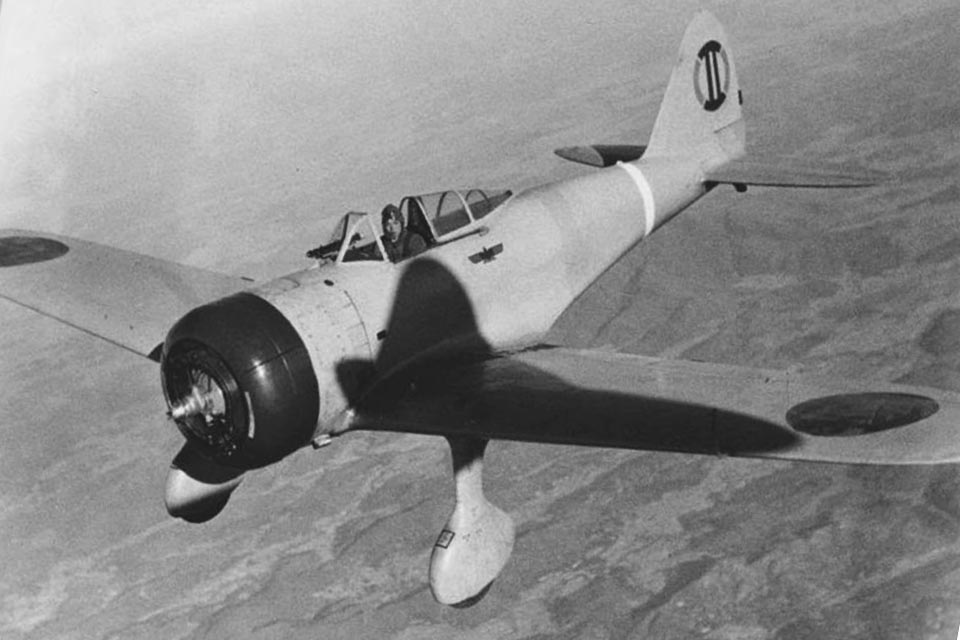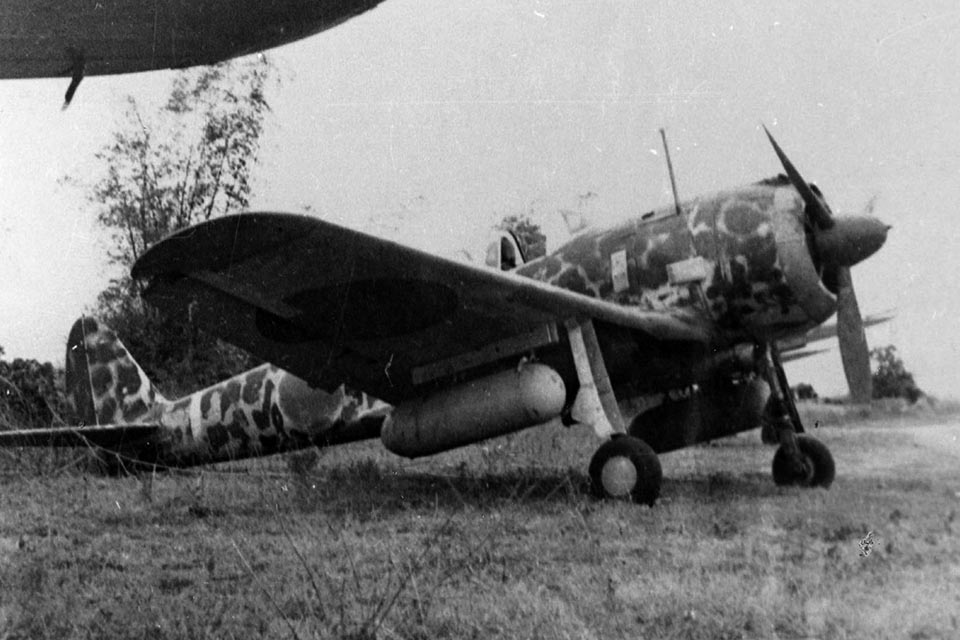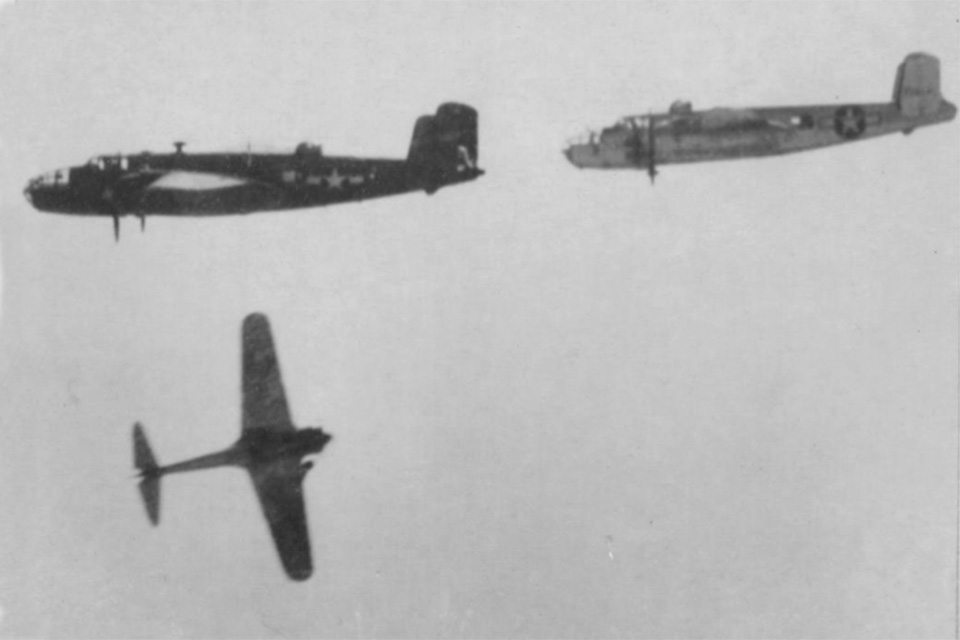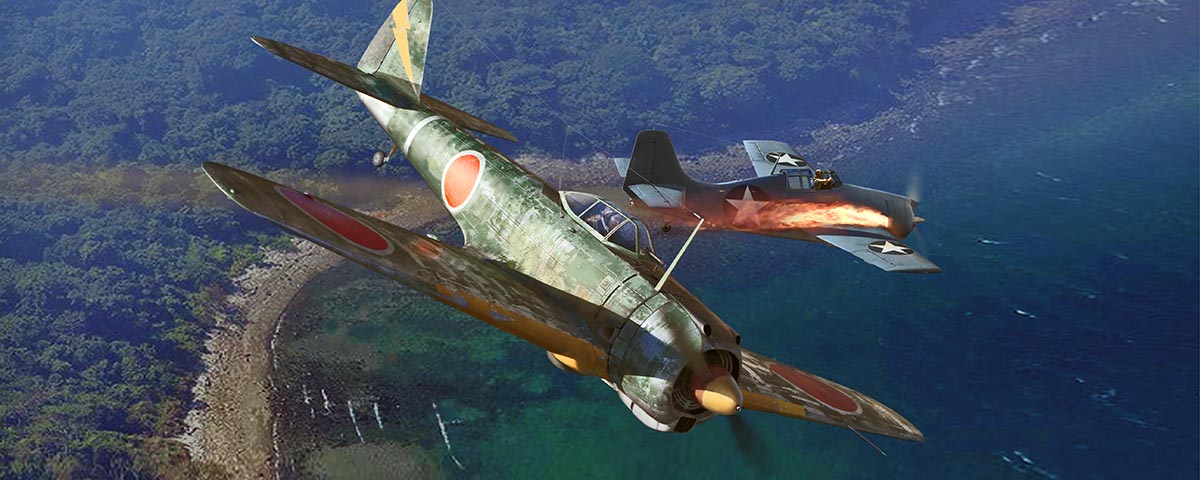After overcoming some teething troubles, the Japanese army’s nimble Ki-43 Hayabusa went on to claim more Allied aircraft than the navy’s vaunted Zero.
By the mid-1930s, the backward inferiority of Japanese aviation had become virtually ingrained in European and American strategic thinking. That complacency was rudely shaken on December 7, 1941, by the carrier-launched aircraft that executed the surprise attack at Pearl Harbor—especially the Japanese navy’s fast, agile and deadly Mitsubishi A6M2 Zero fighter.
At the same time, Allied airmen over Malaya and China were also recording their shock at the Zero’s astonishing performance. In most cases there, however, the Zero’s name and mystique were being passed on to another Japanese “mystery” fighter that was even newer, yet generally inferior to the A6M2. Codenamed “Oscar” by the Allies, the Nakajima Ki-43 Hayabusa (peregrine falcon) became the most numerically important Japanese army air force (JAAF) fighter of the war. And like the Zero, it remained a mainstay for too long.
In the late 1930s, the Japanese army’s principal fighter was the Nakajima Ki-27, a low-wing monoplane with a glazed canopy and fixed landing gear. The Ki-27 had enjoyed considerable success over China and Manchuria, and when the JAAF headquarters laid out a specification for its successor in December 1937, the only major innovation was retractable landing gear. Up to that time, the Japanese regarded the aerodynamic advantages of such undercarriage to be offset by the added weight, but combined with a more powerful engine, the retractable gear was expected to raise maximum speed to 311 mph—an unambitious 7 percent improvement over the Ki-27.

The army was so pleased with its current fighter that it did not even open its new specification to competition, leaving it to Nakajima designers Hideo Itokawa and Yasumi Koyama to improve on the Ki-27’s performance without sacrificing its maneuverability. They responded, roughly as Jiro Horikoshi had done with the navy’s Zero, by designing a slim, lightweight fuselage with a three-spar, one-piece wing around the new 990-hp Nakajima Ha-25 14-cylinder radial engine. The Ki-43 prototype was completed on December 12, 1938, but during test flights in January 1939 it proved to be barely faster and far less nimble than its predecessor, while displaying unsatisfactory takeoff and landing characteristics.
The JAAF was about to suspend further development, but Itokawa won a reprieve by promising to redesign the fighter. Starting with the first preproduction aircraft, Nakajima incorporated new, finer tail surfaces with a fuselage of reduced cross section. But it was the eighth redesign, which introduced Fowler-type “butterfly” flaps for added lift and maneuverability, that revived the army’s enthusiasm. The final preproduction Ki-43, completed in September 1940, featured the butterfly flaps; an uprated Ha-105 engine driving a two-blade, two-pitch metal propeller; and twin Ho-103 12.7mm machine guns in the cowling. Its overall performance exceeded expectations, and the JAAF urged Nakajima to begin production as soon as possible.
Although it was even smaller and lighter than the Zero, the production Ki-43-I’s 308-mph maximum speed was inferior to the carrier fighter’s. Armament also proved to be problematic. The new Ho-103 “automatic cannon” was influenced by the American M2 .50-caliber machine gun, but used an exploding round. The shells were initially unreliable, often barely exiting the barrel before exploding. Consequently, the first Ki-43-I-Ko fighters retained the standard 7.7mm weapons, although Nakajima put an interim Ki-43-I-Otsu model with one 7.7mm and one 12.7mm gun in parallel production. However, Major Tateo Kato, the veteran commander of the 64th Koku Sentai (air regiment), kept two Ho-103s in his fighter, which his armorers scrupulously maintained, to encourage his pilots to “believe in” the 12.7mm gun even while the manufacturer ironed out its shortcomings.
Still more problems arose as the first Ki-43s began replacing Ki-27s in the 59th and 64th sentais in August 1941. A rash of accidents due to structural failure during dives suggested just how much the Nakajima team had sacrificed in the name of weight reduction. The aircraft were returned to Tachikawa, where the wings underwent improvised strengthening. Then, as the likelihood of war with the United States and Britain grew, the 59th and 64th were deployed—alongside the Ki-27s of the 1st, 11th and 77th sentais—for the coming invasion of Malaya.
Major Kato was among the Ki-43’s loudest critics. “He didn’t complain,” recalled his 3rd Chutai (squadron) leader, Lieutenant Yohei Hinoki, in a postwar interview, “he just said he’d make something out of it. In the part where the undercarriage retracts there was a crack. It was wide enough to put your little finger into. The plane was a disaster. We didn’t want to get into it. I got into it feeling very worried, very unhappy. I was scared.”
Stationed on the island of Phu Quoc off the Cambodian coast, the 64th Sentai covered the landings of the Japanese 25th Army at Kota Bharu, Singora and Patani on December 8, 1941 (which, because of the International Date Line, actually occurred slightly before the Pearl Harbor raid). The Ki-43’s first combat mission took place as the 64th’s fighters escorted Mitsubishi Ki-21 bombers over Sungei Patani airfield, where the Brewster Buffaloes of No. 21 Squadron, Royal Australian Air Force (RAAF), were based. That and a previous air raid left the Australians with only four serviceable airplanes. Hinoki and his wingman claimed the Ki-43’s first aerial victory when they caught a Bristol Blenheim Mark IV of No. 34 Squadron trying to bomb the beachhead, and forced it to land at Machang airstrip. On the way home, a Ki-43 of the 3rd Chutai had to ditch in the sea off Phu Quoc after being hit by trigger-happy Japanese destroyer gunners; the rest landed at Phu Quoc with their tanks nearly dry.
By December 17, the JAAF had lost 10 Ki-43s, almost all to noncombat-related causes. The fighters encountered their first sizeable aerial opposition on the 22nd, when Kato led 18 64th Sentai Ki-43s over Kuala Lumpur. The regiment’s 2nd Chutai, under Lieutenant Takeo Takayama, dove on a Buffalo formation and subsequently claimed 11 destroyed—three of which were credited to Takayama—and four damaged. In actuality, RAAF 453 Squadron only had 12 planes up at that time, of which five were destroyed and four damaged. One survivor, Sergeant Gregory Richmond Board, later recalled: “Spotting a ‘Zero’ [actually a Ki-43] below, I half rolled…before I could set up the fighter for the kill, all hell broke loose behind me…the instrument panel exploded and blew apart…brilliant fire gushed from the fuel tanks.” Board managed to bail out, but his summation of the experience spoke for most of his contemporaries: “No one knew what the Zeros were, but they were not slow, ancient, fabric-covered biplanes.”
The Australians claimed three enemy fighters, but the only Japanese loss was Lieutenant Takayama. The tail of his plane, which was found by Indian troops, revealed large-caliber bullet hits, but some of Takayama’s squadron mates swore they had seen his right wing collapse as he was pulling out of a dive. Moreover, an examination upon the 64th’s return to Kota Bharu revealed cracks in the wings of six other aircraft—clearly the alterations at Tachikawa had not been enough. More fundamental strengthening would be necessary on production Ki-43s, but for the time being the ground crews spent the night improvising their own field modifications to reinforce the wing structures, with which the Ki-43 pilots gamely made do. “But to fly it, you had to know what you were doing,” said Hinoki. “If you made a sudden movement, something would break.”
Despite its somewhat premature introduction, the Ki-43 did well in the Pacific War’s early months, partly due to the skill and élan of its experienced pilots, and partly by riding on the Zero’s coattails. Even so, it was fortunate for the Ki-43 pilots that the stunned Allies did not learn of its early weaknesses and take fuller advantage of them. “The enemy would run,” said Hinoki, “but giving chase wasn’t easy. The faster we went, the greater the vibration. It was difficult to take aim.”

While the fighting continued, the Ki-43’s flaws were addressed, and it became as much the army’s workhorse fighter as the Zero was for the navy. Meanwhile, on March 8, 1942, the first published reference to the Ki-43 as “Hayabusa” appeared. This was the propaganda brainchild of public affairs officer Major Masaru Nishihara, and it began a general trend toward naming aircraft that both Japanese services had largely ignored until then.
On May 22, just as the Japanese were completing their conquest of Burma, a Blenheim IV of No. 60 Squadron, RAF, raided the 64th Sentai’s airfield at Akyab and was pursued over the Bay of Bengal by five Ki-43s. Coolly manning his Vickers K gun, Flight Sergeant “Jock” McLuckie damaged two assailants, compelling a wounded Sgt. Maj. Yoshito Yasuda and Captain Masuzo Otani to retire. The last fighter to attack was set afire by McLuckie and dived into the sea, carrying Lt. Col. Tateo Kato, then credited with 18 victories, to his death—a demoralizing blow to the regiment and the JAAF.
At the end of 1942, Consolidated B-24D Liberators began bombing Japanese targets in Burma. The Ki-43 pilots swiftly learned how inadequate their twin 12.7mm guns were against these formidably armed giants, but with more potent fighters such as the Nakajima Ki-44 unavailable in adequate numbers, they had to shoulder the interceptor role. Their solution was to attack head-on, aiming at the cockpit or engines and coming at the bombers in trail formation, with each Hayabusa firing in sequence. These tactics, developed and practiced by leaders such as Captain Yasuhiku Kuroe and Major Toshio Sakagawa, and JAAF ace of aces Sgt. Maj. Satoshi Anabuki, proved effective enough to achieve more victories than losses during 1943. That changed in 1944, however, as growing numbers of Lockheed P-38s and North American P-51s escorted the bombers.
Although it saw its most effective service over mainland Asia, the Hayabusa sometimes appeared over the South Pacific. There it came up against newer generation Allied fighters whose pilots soon learned to take advantage of their robust aircraft’s heavier armament and higher speeds to cancel out the Ki-43’s agility. Worse for the Japanese, the replacements for their steady losses in experienced pilots were not as well trained and more apt to fall victim to Allied opponents of growing competence and confidence.
Nevertheless, there were striking reminders that the Oscar was dismissed at one’s peril. On January 31, 1943, Ki-43s of the 3rd Chutai, 11th Sentai, engaged 12 Guadalcanal-based Douglas SBD-3 Dauntless dive bombers attacking Japanese shipping off Kolombangara and their eight Grumman F4F-4 escorts. One of the Wildcat pilots, 1st Lt. Jefferson J. DeBlanc of Marine squadron VMF-112, had already shot down two Mitsubishi F1M2 floatplanes when someone radioed “Zeros!” In the ensuing dogfight, DeBlanc and Staff Sgt. James A. Feliton of VMF-121 used mutually supporting Thach-weave tactics to engage their aggressive opponents. DeBlanc shot down two of the fighters, but Feliton was hit in the engine. Then, after downing his fifth victim of the day in flames, DeBlanc was nailed by yet another adversary and had to bail out. Both he and Feliton parachuted into Vella Gulf, swam to Kolombangara and were rescued by coast watchers, who eventually arranged their return to Guadalcanal on February 12. DeBlanc was awarded the Medal of Honor. Both he and Feliton were credited to Sergeant Takeo Takahashi, whose score totaled 13 when he was shot down and killed in a transport plane over Manila Bay, Philippines, on November 13, 1944.
Over New Guinea, 1943 saw Ki-43s become fodder for P-38 and Republic P-47D aces of the Fifth Air Force. On March 5, 1944, however, Lt. Col. Neel E. Kearby, leader of the 348th Fighter Group and a Medal of Honor recipient for downing six Japanese in one day, led a P-47 flight against four Kawasaki Ki-48 bombers. Two fell to his men, but Kearby’s target did not. As he swung around for another pass, an escorting Ki-43 of the 77th Sentai scored hits on his cockpit. Making for an Allied airbase, Kearby flew 140 miles before bailing out of his faltering Thunderbolt, only to succumb to his wounds. His remains were found near Pibu in 1946 (see “Pacific Thunderbolt Ace,” July 2016 issue).
Even America’s second-ranking ace fell victim to the Ki-43’s maneuverability—and his own overconfidence. On January 7, 1945, four P-38Ls from the 475th Fighter Group were patrolling between the Philippine islands of Mindoro and Negros at 1,500 feet when a lone Oscar came at them from below. Captain Edwin Weaver and his squadron commander, Lt. Col. Thomas B. McGuire Jr., turned to attack it, but Master Sgt. Akira Sugimoto of the 54th Sentai evaded them and fired a burst into the left engine of 1st Lt. Douglas S. Thropp Jr.’s Lightning. Major Jack Rittmayer, a visiting Thirteenth Air Force pilot, drove the Ki-43 off Thropp’s tail, but Sugimoto then attacked Weaver. Hastening to Weaver’s aid—and eager to get his 39th victory—McGuire pulled into a tight turn. As he came within range of the elusive Oscar, his P-38, weighted down by the auxiliary fuel tanks he had refused to jettison, abruptly fell into a full stall, snap-rolled onto its back and crashed in flames on Negros. For sacrificing his life to save Weaver, McGuire received a posthumous Medal of Honor.
Sugimoto escaped into the overcast, but Thropp’s and Rittmayer’s fire had damaged his Ki-43, forcing him to make a wheels-up landing on Negros. He was still in the cockpit when he was found and shot by Filipino guerrillas.
In December 1942, the 64th Sentai in Burma had received the first improved Ki-43-IIas, which featured stronger, shorter-span wings with racks for bombs or auxiliary fuel tanks. A 1,150-hp Nakajima Ha-115 engine with two-speed supercharger in a redesigned cowling, driving a three-blade metal airscrew, increased speed to 329 mph at 13,000 feet. The improved Hayabusa also featured a taller windscreen, a more effective reflector gunsight, armor plate behind the pilot and self-sealing fuel tanks. If pilots had a complaint, it was that the third propeller blade reduced the rate of fire for its synchronized Ho-103 guns to 400 rounds per minute.
“It was now a plane you could fly with confidence—a great machine,” remarked ace Yohei Hinoki, who lost a leg in combat but survived the war. “But when it had become a good attack plane, things were changing. It was now to be used for defense, as an interceptor. So again its firepower was insufficient and it lacked the speed needed for attacking bombers. The ‘Oscar’ was coming to the end of its time.”
On June 20, 1943, the 59th Sentai, operating from Babo, New Guinea, added Australia to its area of operations when 22 of its Ki-43-IIs escorted 18 Nakajima Ki-49 bombers attacking Winnellie and nine Ki-48s hitting Winnellie and Darwin. They were met by 46 Supermarine Spitfire Mark Vs of the 1st Fighter Wing, RAAF, whose pilots claimed nine bombers and five fighters. The Japanese recorded just one Ki-49 and one Ki-43 lost, as well as another shot-up Ki-49 and two Ki-48s force-landing upon returning to base. The 59th Sentai claimed nine Spitfires and six probables, compared to actual RAAF losses of three Spitfires and two pilots.
Japan’s December 5, 1943, airstrike on Calcutta, India, was arguably the high tide for the Ki-43 in Asia. This exceptional raid involved not only 27 Ki-21 bombers, escorted by 101 Hayabusas from the 33rd, 50th, 64th and 77th sentais, but also nine Mitsubishi G4M1 naval bombers and 27 A6M3 Zeros. Calcutta’s defenses included newly arrived RAF Spitfire Vcs of No. 136 Squadron and Hurricane Mark IICs of Nos. 67 and 176 squadrons.
The Japanese army planes were first to arrive, bombing the King George’s dock. British fighters shot down one Ki-21, but Hayabusa pilots claimed four Hurricanes destroyed and two damaged, for the loss of one Ki-43 and one damaged. Twenty minutes later, the G4Ms bombed the Kittapore docks. Five Hurricanes from 176 Squadron attacked them, only to be jumped by the Zeros, whose pilots were credited with six. In actuality, the British lost three Hurricanes and two pilots killed, including six-victory ace Flying Officer Arthur M.O. Pring. All the G4Ms returned unharmed. Successful though it was, the Calcutta raid was the only major Japanese air operation to involve both army and navy aircraft in Asia.

On May 26, 1944, 60,000 troops of the Japanese 11th Army in China embarked on Operation Ichi-Go (Number One), a major offensive intended to open a rail link between Shanghai and Hanoi, destroy the Nationalist Chinese army and push the U.S. Fourteenth Air Force back so its bases could not be used by B-29s to attack Japan. The main Japanese fighter over the next several months was the Ki-43-II, and its main opposition was the latest model of an equally aging fighter, the Curtiss P-40N. Usually the advantage was held by the Warhawks, flown by pilots who knew better than to be drawn into low-level turning contests with the Oscars—and who could replace their losses more quickly than the Japanese could. In August 1944, the 22nd Sentai arrived in China, equipped with the first of a new generation of army fighters, the Nakajima Ki-84 Hayate (gale). By then, however, the Americans were replacing their P-40s with P-51 Mustangs.
Still the Ki-43s fought on, over Formosa, the Philippines, the East Indies and the Home Islands, with many ending up as suicide planes during the Okinawa campaign. At the Hayabusa’s peak, 36 regiments were equipped with it; by August 1945, 18 still were. The Ki-43’s continuing ubiquity was largely due to the Ki-84’s new engine, which was more powerful but also chronically unreliable, on top of which Japanese industry could not produce enough of them. Because of its prolonged usage over a wider area of operations—combined with overoptimistic victory claims—more Ki-43 pilots became aces and were credited with more aerial victories than their colleagues flying Zeros.
In a desperate effort to keep the Hayabusa competitive, Nakajima—like Mitsubishi with the Zero—incorporated various refinements into the Ki-43-IIb and Ki-43-IIc, the latter of which introduced ejector exhaust stubs that provided slightly more speed. In mid-1944, Nakajima installed a 1,190-hp Ha-115-II engine in the Ki-43-IIIa, which could do 363 mph. Tachikawa built 1,098 Ki-43-IIIas along with two prototype Ki-43-IIIbs with a pair of Ho-5 20mm cannons. The war ended before the Ki-43-IIIc, with an Ha-112-32/42 engine and two 20mm cannons, intended to intercept B-29s, could enter production.
A total of 5,751 Ki-43s were delivered by war’s end. Remarkably, Japan’s surrender on September 2, 1945, did not mark the end of their service career. The Royal Thai Air Force continued to use them, the Communist Chinese acquired examples from the Manchukuo air force when they overran Manchuria in October 1945, and the Indonesian People’s Security Force assembled some from components found in a Djakarta dump. All served well into the late 1940s, as did captured Ki-43s used by the French against the Viet Minh in Indochina.
In a way, Nakajima also survived. Although it was broken up into 15 smaller companies after the war, five of them later reunited under the aegis of Fuji Heavy Industries, whose best-known product in the United States is the Subaru automobile.
For further reading, Aviation History research director Jon Guttman recommends: Ki-43 ‘Oscar’ Aces of World War 2, by Hiroshi Ichimura; P-40 Warhawk vs Ki-43 Oscar, by Carl Molesworth; and B-24 Liberator vs Ki-43 Oscar, by Edward M. Young.
This story was published in the May 2017 issue of Aviation History magazine. Subscribe here.

